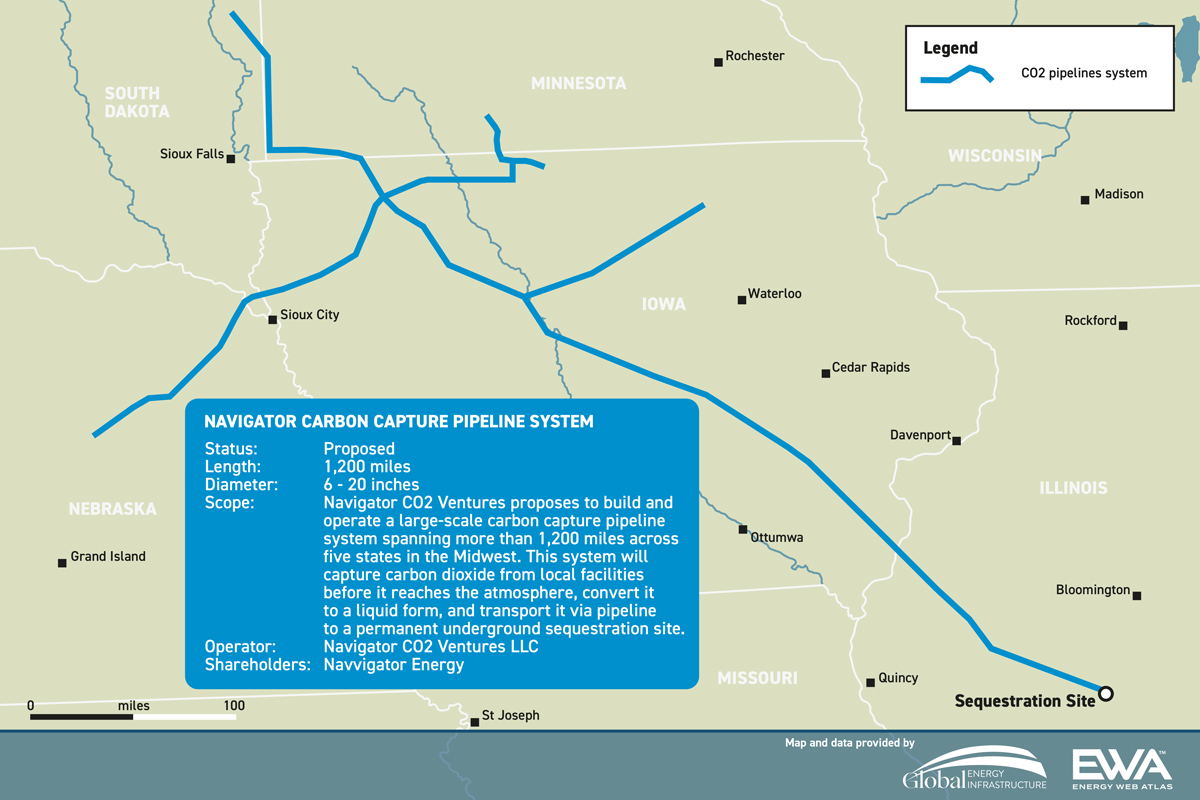1,200 Mile CO2 Pipeline to Create Positive Ripples in its Community
By Maddy McCarty, P&GJ Digital Editor
Navigator CO2 Ventures’ planned 1,200-mile carbon capture pipeline system across the U.S. Midwest should prevent up to 12 million metric tons of carbon from being released into the atmosphere each year.
Outside of its environmental benefits, the carbon capture and permanent sequestration offers tax breaks and increased profit, leading to more profitable products, job creation and security, Navigator CEO Matt Vining said.
After a successful non-binding open season, Navigator is now in its binding open season for the project which will provide biorefineries and other industrial customers a long-term, economic path to materially reduce their carbon footprint by capturing and transporting CO2 across five Midwest states to a permanent sequestration site.
Based on feedback from potential customers, Navigator is looking to expand the capacity of the pipeline and proceed with multiple sequestration sites, creating an injection capacity of up to 12 million metric tons per year.
Navigator previously announced its partnership with BlackRock Global Energy & Power Infrastructure Fund to develop the carbon capture system (CCS) in Nebraska, Iowa, South Dakota, Minnesota and Illinois. Valero Energy Corporation is the anchor customer.
PIPELINE CONSTRUCTION
All of the pipeline in this project will be new pipeline, Vining said, and its 1,200 miles will make it about 1.5 to 2 times bigger than some of the largest crude and gas pipelines in the Permian Basin.
CO2 is a heavier molecule than some liquid materials transported in pipelines, so the pipes will be made of steel and utilize higher pressure to pump the liquid, he said, but overall the construction will be similar to crude and gas pipeline construction.
“CO2 in a liquid form is very analogous to handling any hydrocarbon in a liquid form, it's just a heavier molecule,” Vining said. “It has the same turbulent flow and it's the same compressors and meters that we used in other applications, so this is not surgery.”
The binding open season closes Sept. 1, then the company expects permitting to take 14 to 18 months since the permitting process varies by state. Construction will then take another 20 to 24 months. Some customers may start service in the fourth quarter of 2024, while Navigator will continue to add service through the first half of 2025.
BENEFITS
Some producers can get a tax credit of $50 per metric ton of carbon that is permanently sequestered rather than emitted, Vining said. An ethanol site that emits 250,000 metric tons per year, for instance, could receive a $12.5 million tax credit, he said.
By sequestering the carbon and reducing its carbon intensity, an ethanol facility may achieve a better price at Low-Carbon Fuel Standard markets, Vining said. This could result in an increase of up to 20 to 40 cents increased price per gallon, resulting in a revenue gain of $20 to 40 million a year, Vining said.
At full capacity, Navigator’s CCS is designed to able to capture and store 12 million tons of CO2 per year – the annual equivalent of removing approximately 2.6 million cars from the road, planting 550 million trees per year or eliminating the of Kansas City 1.5 times over. According to the International Energy Agency, carbon capture and storage projects have the ability to reduce global CO2 emissions by almost 20%, and lower the cost of addressing climate change by 70%.
“This is this is going to be the first of its kind at this scale, and that's very exciting,” Vining said. “This is the first phase of a multi-phase project that is likely going to be much bigger and it will take many more counterparties than what we're going to accomplish over the next three to four years.”
It would be hard to “understate the enormity of the build out that will be required” to meet some of the federally stated objectives related to emissions, he said.
Related News
Related News

- Keystone Oil Pipeline Resumes Operations After Temporary Shutdown
- Freeport LNG Plant Runs Near Zero Consumption for Fifth Day
- Biden Administration Buys Oil for Emergency Reserve Above Target Price
- Mexico Seizes Air Liquide's Hydrogen Plant at Pemex Refinery
- Enbridge to Invest $500 Million in Pipeline Assets, Including Expansion of 850-Mile Gray Oak Pipeline





Comments